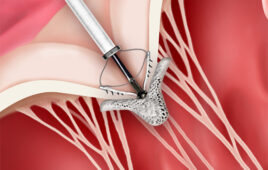FREMONT,
Calif.–(BUSINESS WIRE)–Emboline, Inc., an
emerging medical device company, has received Notice of Allowance from the
United States Patent and Trademark Office (USPTO) related to its aortic embolic
protection devices for percutaneous heart valve repair and replacement. The
Company is initially focused on developing its novel Emboline CAP™ device: a
game-changing, next-generation system intended to provide complete protection
of the arterial bed (both the cerebrals and the aortic lumen) utilizing a
uniquely ported design that maintains tool access through the filter. In
addition, Emboline is also developing Emboliner™, a simple-to-use system for
protection of the cerebral vessels alone.
Embolines technologies are derived from intellectual
property invented by Amir Belson, M.D., founder of Neoguide Systems, a company
that developed platform technology for minimally invasive surgical procedures
and was acquired by Intuitive Surgical in 2009.
“Our emergence is timely, given the significant attention on
transcatheter aortic valve replacement at this months TCT 2011 conference,”
said Scott Russell, Embolines General Manager. “For these exciting new TAVR
procedures to realize their clinical potential, the risk of stroke must be
rigorously managed. Our technology is designed not only to eliminate the risk
of embolic stroke from TAVR procedures, but it is also the only technology
designed to simultaneously shield the aortic lumen in order to protect the rest
of the arterial bed as well. No doubt, allowance of this patent fortifies the
competitive advantage of our IP portfolio and is a critically important
milestone in our comprehensive strategy for device development in the aortic
embolic-protection space.”
Emboline is working toward an acute preclinical
proof-of-concept of its technology, targeted by Q1 2012. The proof-of-concept
development is being done in partnership with NDC (Fremont,
Calif.), SeptRx, Inc. (Fremont,
Calif.) and US BioDesign (Perkasie, Penn.).
CLINICAL NEED
Cerebral embolism is a known complication of cardiac surgery, cardiopulmonary
bypass and catheter-based interventional cardiology and electrophysiology
procedures. Embolic particles, which may include thrombus, atheroma and lipids,
may become dislodged by surgical or catheter manipulations and enter the
bloodstream. Cerebral embolism can lead to neuropsychological deficits, stroke
and even death. Other organs downstream can also be damaged by embolism,
resulting in diminished function or organ failure. Prevention of such embolism
would benefit patients and improve the outcome of these procedures. These risks
are especially critical in transcatheter aortic valve replacement (TAVR).
Stroke rates related to TAVR have been recorded at between four and 20 percent.
During catheter delivery and valve implantation, plaque may be dislodged from
the vasculature and may travel through the carotid circulation and into the
brain. The adoption and growth of TAVR procedures may be stifled until a
reliable, simple-to-use embolic protection system exists to improve the safety
of these procedures.
For further information about Embolines technologies,
please contact Scott Russell (General Manager) at srussell@emboline.com,
510/225–9258, x1.
Posted by Sean Fenske, Editor-in-Chief, MDT




